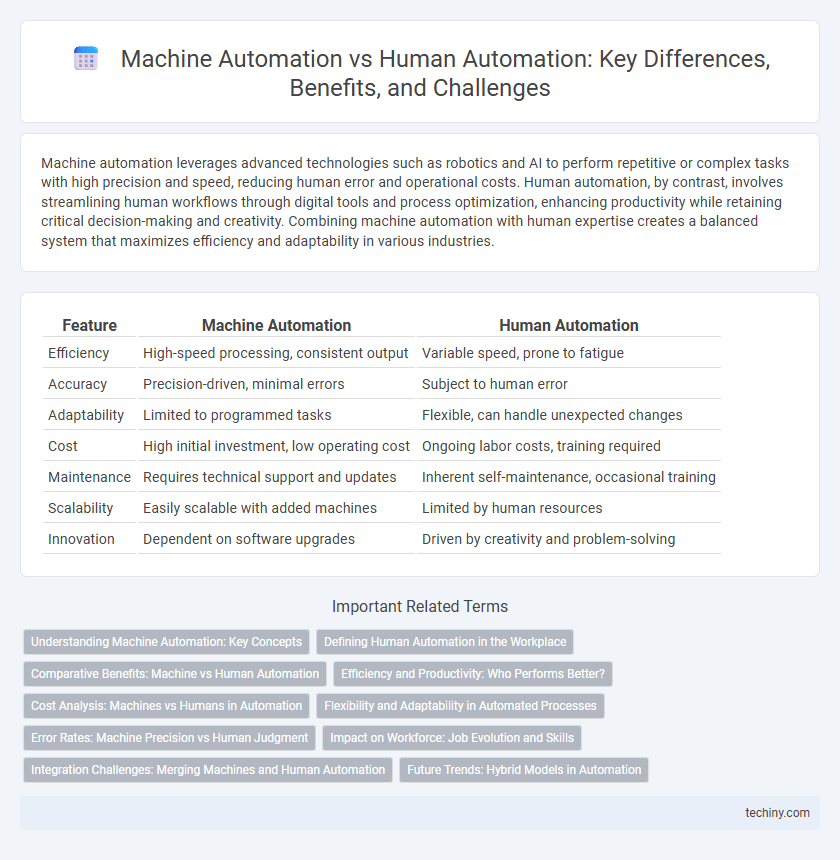Machine automation leverages advanced technologies such as robotics and AI to perform repetitive or complex tasks with high precision and speed, reducing human error and operational costs. Human automation, by contrast, involves streamlining human workflows through digital tools and process optimization, enhancing productivity while retaining critical decision-making and creativity. Combining machine automation with human expertise creates a balanced system that maximizes efficiency and adaptability in various industries.
Table of Comparison
| Feature | Machine Automation | Human Automation |
|---|---|---|
| Efficiency | High-speed processing, consistent output | Variable speed, prone to fatigue |
| Accuracy | Precision-driven, minimal errors | Subject to human error |
| Adaptability | Limited to programmed tasks | Flexible, can handle unexpected changes |
| Cost | High initial investment, low operating cost | Ongoing labor costs, training required |
| Maintenance | Requires technical support and updates | Inherent self-maintenance, occasional training |
| Scalability | Easily scalable with added machines | Limited by human resources |
| Innovation | Dependent on software upgrades | Driven by creativity and problem-solving |
Understanding Machine Automation: Key Concepts
Machine automation involves using advanced robotics, artificial intelligence, and control systems to perform tasks traditionally done by humans, increasing precision and efficiency in manufacturing and service industries. Key concepts include programmable logic controllers (PLCs), sensory feedback loops, and machine learning algorithms that enable adaptive decision-making and real-time adjustments. Understanding these elements is crucial for optimizing production workflows and reducing operational costs in automated environments.
Defining Human Automation in the Workplace
Human automation in the workplace refers to the strategic integration of technology and processes that enhance employee efficiency by automating repetitive tasks while retaining human decision-making and creativity. It involves optimizing workflows through tools such as robotic process automation (RPA) and AI-driven assistance, enabling workers to focus on complex problem-solving and innovation. This approach balances the strengths of human insight with automation capabilities, improving productivity and job satisfaction.
Comparative Benefits: Machine vs Human Automation
Machine automation excels in processing speed, accuracy, and consistency, reducing operational errors and increasing overall productivity. Human automation offers flexibility, creative problem-solving, and adaptability in complex or unpredictable environments where machines may struggle to interpret nuanced data. Integrating machine automation with human oversight maximizes efficiency while leveraging human intuition and decision-making skills.
Efficiency and Productivity: Who Performs Better?
Machine automation significantly outperforms human automation in efficiency and productivity by executing repetitive tasks with consistent speed and accuracy, minimizing errors and downtime. While human automation offers adaptability and problem-solving skills, machines excel in high-volume, standardized processes where speed and precision are critical. Data from industries such as manufacturing and logistics show up to 50% productivity gains when integrating machine automation compared to manual human workflows.
Cost Analysis: Machines vs Humans in Automation
Machine automation significantly reduces long-term operational costs by minimizing labor expenses and increasing production speed, despite requiring initial capital investment and maintenance costs. Human automation involves higher ongoing costs due to wages, benefits, and possible human error, which can lead to inefficiencies and increased quality control expenses. Cost analysis reveals that industries with repetitive and precise tasks benefit more from machine automation, while human-based automation remains essential for complex decision-making and adaptable processes.
Flexibility and Adaptability in Automated Processes
Machine automation excels in repetitive tasks with high precision but often lacks the flexibility and adaptability required to handle unexpected changes or complex decision-making. Human automation, driven by cognitive skills and intuition, offers superior adaptability in dynamic environments and can adjust processes based on real-time context. Integrating both approaches optimizes automated processes by leveraging machine efficiency and human flexibility, enhancing overall operational resilience.
Error Rates: Machine Precision vs Human Judgment
Machine automation typically delivers significantly lower error rates due to consistent precision and repeatability in executing tasks, reducing variability caused by fatigue or distraction. Human automation, while more adaptable to complex and ambiguous situations, often exhibits higher error rates influenced by cognitive biases and inconsistent judgment. Leveraging machine precision in processes requiring high accuracy enhances efficiency and minimizes costly mistakes compared to relying solely on human intervention.
Impact on Workforce: Job Evolution and Skills
Machine automation transforms the workforce by shifting job roles from repetitive tasks to more complex problem-solving and creative functions, requiring reskilling and upskilling of employees. Human automation emphasizes augmenting employee capabilities with technology, promoting collaboration between humans and machines to enhance productivity while preserving core human skills. The evolving job landscape demands continuous learning, adaptability, and integration of digital competencies to thrive in automated environments.
Integration Challenges: Merging Machines and Human Automation
Integration challenges in machine automation versus human automation often arise from differences in operational speed, precision, and adaptability between machines and humans. Synchronizing robotic processes with human tasks requires advanced interface design and real-time data sharing to ensure seamless workflow and minimize errors. Effective integration demands robust communication protocols, adaptive control systems, and comprehensive training to align machine capabilities with human decision-making and flexibility.
Future Trends: Hybrid Models in Automation
Hybrid models in automation combine machine efficiency with human creativity to optimize workflows and decision-making processes. Advances in AI-driven robotics and human-in-the-loop systems enable seamless collaboration, enhancing productivity and adaptability in dynamic environments. Future automation trends emphasize integrating cognitive capabilities of humans with the precision of machines to achieve scalable, intelligent automation solutions.
Machine Automation vs Human Automation Infographic

 techiny.com
techiny.com